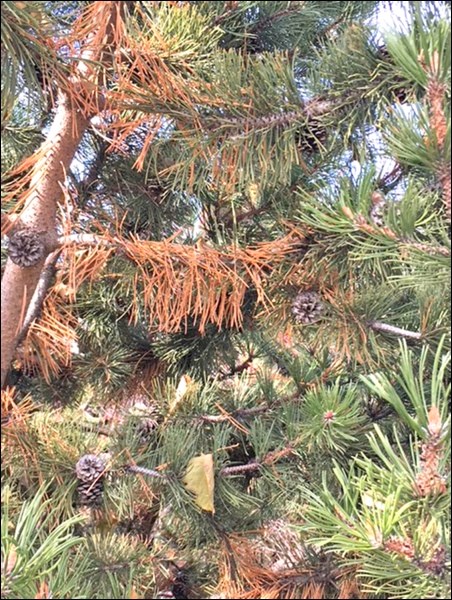If you have a needle tree (evergreen) in your landscape you’ve probably noticed some discolouration (yellowing or browning) in some of the interior needles around this time. This discolouration usually starts in August and continues right through to freeze up. It is particularly noticeable in pine trees and less so in spruce.
Don’t panic. The loss of older interior needles in the fall is completely natural, but it can be confused with injury, disease or insect infestation. Sometimes the yellowing/browning of these needles goes unnoticed since the needles on the inside of the evergreen are hidden by the foliage on the outside of the tree. The dropping of needles on evergreens usually takes place in a gradual manner but, depending upon the season and environmental stresses like drought that a tree experiences, many needles can discolour all at once, and make the tree or shrub look like it is dying. The evergreen foliage throughout the interior of conifers turns yellow, then brown, and finally drops off. The branchlets of some cedars will do this same browning and dropping of older interior leaves. The oldest, or innermost, needles of spruce, pine and fir shed first.
So here’s the deal, if pine needles turn brown from the interior of the tree, and the outer needles stay green, there is usually no cause for concern.
Needles don’t last forever.
Like deciduous (leaf) trees that shed their leaves every fall, evergreen trees also lose their old needles in the late summer and through the fall. The age of needles that drop off an evergreen tree, interestingly, varies from species to species.
Pine tree needle drop can vary from two-year-old needles dropping on Scots pine, to 14- to 17-year-old needles dropping as on a pine called Bristlecone. Colorado spruce needles can stay on the tree for eight to 10 years. The point is, there are always needles coming of age on a tree and there is an annual shedding of these older needles. The quantity of dropped needles varies from year to year.
Winter Color
The other thing that happens to some species of pines is a natural yellowing when the temperatures get colder. This yellowing usually corrects itself and returns to the deep green in the spring when it is warmer and the needles begin to produce food again. There are several juniper species that turn purple or purple-brown as the temperatures drop in the fall. This is no cause for concern either and is merely a sign of dormancy. Their colour too will improve when the dormant season ends and chlorophyll is produced once again.
Parting advice for prairie gardeners: Don’t forget to water in your landscape for winter to avoid winter desiccation and to help reduce winter sunscald. You can start this now. Always use the fall colouring of the leaves on the leaf trees as your cue to begin your fall watering.




